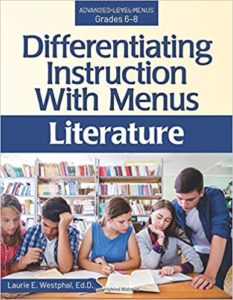Offering Student Choice Using a Menu Strategy
Differentiating Instruction With Menus: Literature (Grades 6-8)
By Laurie E. Westphal, Ed.D.
(Prufrock Press, 2019 – Learn more)
 Reviewed by Erin Corrigan-Smith
Reviewed by Erin Corrigan-Smith
Student Choice. The words alone are enough to send chills down almost any educator’s spine. There is something inherently frightening about choice when we frame it as a release of control in the classroom.
Educators have been taught and told that we are the experts in the classroom, and that we know best when it comes to student lessons. But what happens if we release some of that control and pass it on to students so that they may take ownership of their learning? Research suggests that they often learn more.
 Enter the Choice Board or Student Menus. These tools go by many names, but they mean the same thing: a collection of options for students to choose how they illustrate their mastery of a subject.
Enter the Choice Board or Student Menus. These tools go by many names, but they mean the same thing: a collection of options for students to choose how they illustrate their mastery of a subject.
Students are given more control over their learning process, and so they are more apt to work harder at showing their mastery. As control is released to the student, the learning becomes more meaningful and impactful to the student.
Laurie E. Westphal’s book Differentiating Instruction With Menus: Literature is a wonderful starting point for those educators who are interested in offering choice boards for their students but aren’t sure how to begin – and maybe a little afraid.
Westphal’s book is a comprehensive introduction to student choice and how to make that successful in a grades 6-8 setting. (Westphal has also written editions for grades 3-5 and grades 9-12.)
Getting started with menus
Almost a quarter of the book is devoted to teacher needs when it comes to student choice. Westphal explains the menu idea and gives academic research-based reasoning for including menus in the classroom. The first fifty pages are a great way to calm any nerves or to explain away concerns when it comes to choice. The menus are described and explained as to their efficacy in the classroom, and readers are given the reasoning for their inclusion in the choice board menus.
Chapter 3 is devoted to expectations and how to relay those to students prior to their being given a menu. For products to meet the expectations, it is imperative that teachers understand what we are asking for. This chapter gives tangible examples of realistic products so that the rigor remains with the choice work.
Looking into genres
Chapters 5 and 6 divide types of literature for students to choose from and for how it can be delivered back in the class. Chapter 5 is all about “Novels, Short Stories, and Drama” and Chapter 6 is devoted to “Poetry.” Each chapter has a selection of popular readings that can be found in almost any classroom, and the stories are diverse. Though the selections in Chapter 6 are popular, they are not as diverse as Chapter 5. Honestly, this does not seem to matter because the options can be easily modified for any poetry lesson, so these choices are a good springboard for a choice board.
Rubrics are included, and there is a section for how to check for standards alignment with different states.
For any teacher interested in offering choice, but who is unsure of how to begin, this book is a valuable tool for how to offer a menu and be sure students “order” the correct items for a fulfilling educational experience.
Editor’s note: Laurie Westphal has also written books about differentiating with menus for math, science, social studies and English language arts. See a list and her video.)
Erin Corrigan-Smith is a middle school ELA teacher in a suburb of Atlanta. She has a B.A. and a M.A. in English, and her focus of study is children’s literature. During the school year, she is faculty advisor to the Book Worms book club. In her downtime, she enjoys going to her family’s cabin in the North Georgia mountains, with her husband and dog, to read, craft, and relax.































